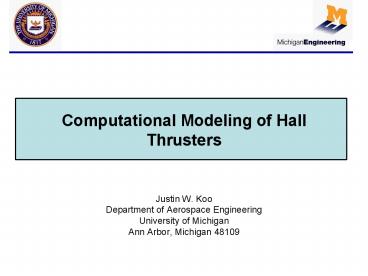Computational Modeling of Hall Thrusters - PowerPoint PPT Presentation
1 / 18
Title:
Computational Modeling of Hall Thrusters
Description:
Rocket Equation. Force balance on a spacecraft. Neglect gravity and drag forces and integrate ... LEO to Moon. 3200 m/s. LEO Escape. 4200 m/s. LEO to GEO. 7600 ... – PowerPoint PPT presentation
Number of Views:166
Avg rating:3.0/5.0
Title: Computational Modeling of Hall Thrusters
1
Computational Modeling of Hall Thrusters
- Justin W. Koo
- Department of Aerospace Engineering
- University of Michigan
- Ann Arbor, Michigan 48109
2
Overview
- Motivation
- Hall Thruster Background
- Computational Modeling
- Results
- Acknowledgements
3
Rocket Equation
- Force balance on a spacecraft
- Neglect gravity and drag forces and integrate
Table from Mechanics and Thermodynamics of
Propulsion, 2nd Edition, Peterson and Hill, 1992
4
Specific Impulse
- Thrust per unit mass propellant (measured in s)
- Put this into the rocket equation
5
Chemical vs EP
- Chemical Propulsion
- Limits on propellant exit velocity are based on
thermodynamic properties of propellant and
material properties of combustion systems - Typical Isp between 150 s and 450 s
- High thrust applications (especially Earth to
LEO) - Electric Propulsion (EP)
- Limits on propellant exit velocity are based on
power supply mass and lifetime issues - For Hall thrusters typically between 1500 s and
2500 s - Low thrust applications (LEO to GEO and beyond)
- Tradeoff between thrust and Isp
6
LEO to Mars
- Suppose Dv 5700 m/s is required
- With typical bipropellant chemical propulsion
- Isp 250 s
- Ideal Payload Fraction 9.8
- With EP (Hall Thruster)
- Isp 1600 s
- Ideal Payload Fraction 69.5
- Primary present application is to satellite
stationkeeping which requires small DV
corrections over a number of years with savings
of hundreds of pounds on satellites that weigh
thousands of pounds
7
Hall Thruster Performance
- UM/AFRL P5 3 kW, 300 V, 10 A operating condition
with a thrust of 180 mN, Isp of 1650 s, and
efficiency of 51 - NASA-457 M gt50 kW operating condition with
thrust of nearly 3 N, Isp of 1750s - 3250 s, and
efficiencies of 46 - 65
UM/AFRL P5 Photo courtesy of PEPL
8
Hall Thruster Schematic
Schematic courtesy of PEPL
9
UM/AFRL P5
UM/AFRL P5 Video courtesy of PEPL
10
Modeling Benefits
- Many good reasons to develop computational Hall
thruster models - Spacecraft Integration
- Existing plume models need better boundary
conditions at the device exit - Contamination of solar panels and sensitive
instruments - Quantify chamber effects
- Vacuum chamber performance of Hall thrusters is
affected by finite neutral background density - Virtual life tests
- Thruster lifetimes (gt8,000 hours) require erosion
modeling to determine lifetime limiting design
characteristics - Understand physics relevant to thruster operation
- Experimental measurements inside device are
limited by probe dimensions, probe lifetime and
other (optical, RF) access issues
11
Computational Model
- 2-D axisymmetric hybrid PIC-MCC
- Domain includes acceleration channel and
near-field of dielectric wall-type Hall thruster - Based on a quasi-neutral plasma description
- Heavy particles (Xe, Xe, Xe ) are treated with
a PIC-MCC model - 1-D energy model assumes isothermal maxwellian
electron distribution along magnetic field lines - Plasma potential based on Ohms Law formulation
- Anode region potential model based on generalized
analytic Bohm criterion
12
Computational Schematic
13
SPT-100 Plasma Density
14
SPT-100 Potential
15
Mobility Modeling
- Calculated from classical transverse electron
mobility form - Electron momentum transfer frequency is
supplemented by a modeled bohm mobility term or
wall-collision term
16
P5 Mean Plasma Density
Experimental
Computational
17
P5 Mean Potential
Experimental
Computational
18
Acknowledgements
- Department of Energy Computational Science
Graduate Fellowship































